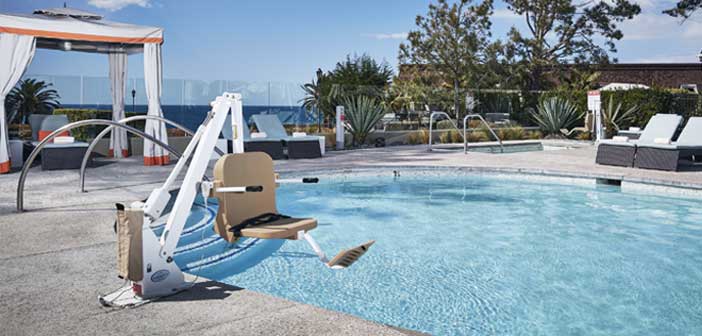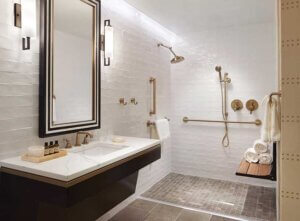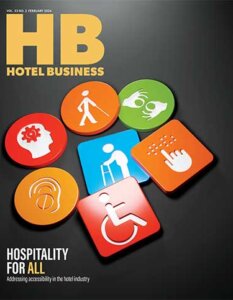Accessibility in the hospitality industry is not a new subject. For decades, hotels would install ramps at the entrances of their properties and grab bars in guestroom bathrooms. But, on July 26, 1990, President George Bush signed the Americans with Disabilities Act (ADA) into law, therefore making hotels accessible to all a top priority for every hotelier across the U.S.
Specifically, it was Title III of the ADA found in Title 42 of the U.S. Code, in Section 12182 that set everything in motion.
“The laws that apply to the hotel industry when it comes to individuals with disabilities are the same laws that apply to all places of public accommodation,” said Charles S. Marion, partner, BlankRome, an international law firm. “Title III prohibits discrimination based on disability in the activities of places of public accommodations. Businesses that are generally open to the public fall into one of 12 categories listed in the ADA, one of which is hotels.”
Chip Rogers, president/CEO, American Hotel & Lodging Association (AHLA), called the ADA “an important civil rights law that hoteliers have always supported because they want to provide a welcoming experience for every guest.”
Violations of the ADA do not only fall under federal jurisdiction. There are also state and local statutes that could come into play.
“In the ADA litigation brought against hotels, we’ve also seen claims brought under certain state and local statutes that also prohibit discrimination against individuals with disabilities,” Marion noted, citing California’s Unruh Civil Rights Act, New York State’s Human Rights Law and the New York City Human Rights Law as examples.
According to World Health Organization (WHO) figures for 2023, an estimated 1.3 billion people—about 16% of the global population—currently experience a significant disability. It’s up to hoteliers to do everything they can to ensure these potential guests don’t let their disabilities stop them from traveling.
“Accessibility for all to tourism facilities, products and services should be a central part of any responsible and sustainable tourism policy,” said Stephen Cluskey, cofounder/CEO, Mobility Mojo, a software solution that empowers hotels and workplaces to create more inclusive and accessible environments. “Accessibility is not only about human rights. It is a business opportunity for destinations and companies to embrace all visitors and enhance their revenues.”
Helping hands
Several companies and organizations offer help to hoteliers with accessibility concerns. The AHLA is one of them.
“We offer a number of resources and guides to help members navigate the ADA,” said Rogers. “We work closely with the U.S. Access Board, a federal agency responsible for developing guidelines and standards for the ADA, as well as the Department of Justice. The hotel industry also has a representative on the American National Standards Institute (ANSI), which creates accessibility and safety guidelines for U.S. businesses to ensure that the industry perspective is heard.”
He suggested hoteliers go to the ADA Checklist for New Lodging Facilities on the ADA website (archive.ada.gov/hsurvey.htm) to find requirements for making a hotel ADA-complaint, including rules for accessible guestrooms, indoor and outdoor public areas and parking lots.
Cluskey’s Mobility Mojo helps hotels conduct a detailed and comprehensive self-evaluation of their level of accessibility.
“Our self-evaluation tool is designed for facilities managers to walk through their premises and using a smartphone, answer questions, take measurements and take photos to capture the current level of accessibility in their building,” said Cluskey, who is confined to a wheelchair following a spinal cord injury. “The hotel product is based on 260-plus accessibility criteria that correlate to top international standards on accessibility, covering mobility, sight, hearing, neurodiversity and inclusion.”
The evaluation, which takes two to four hours to complete, covers various aspects of the building, such as parking, entrances, wayfinding, signage, elevators, guestrooms and restrooms.
“Upon completion, each building receives an accessibility rating showing the current level of accessibility and a comprehensive gap analysis report, which offers clear and actionable recommendations through CapEx light (quick win) suggestions and CapEx intensive for larger areas to improve,” he added. “Large hotel chains with multiple locations across different regions also receive a global overview report, highlighting accessibility trends across their portfolio.”
According to Cluskey, roughly 10% of all hotel guestrooms globally are accessible bedrooms, but they’re rarely sold unless they are requested.
“That’s potentially 10% of the hotel inventory left unsold,” he noted. “Using the Mobility Mojo evaluation process empowers hotels to promote these rooms with accessible information upfront. This serves to drive not only revenue from those with accessibility needs, but those who are traveling with them. In many cases, people with accessibility needs use the hotel facilities if they are suitable for their needs rather than leave the property. This, in turn, drives additional revenue.”
Designing accessible spaces
Developers, architects and designers must plan for ADA compliance in their hotel projects.
Micma Group, a disability access consulting firm, assists developers, lenders, architects, designers and contractors in confirming their projects meet ADA requirements. Mario Ahumada, managing member, Micma Group, said, “New facilities and those which have undergone major renovations are mostly up to par, while existing facilities that have not been renovated recently have some catching up to do.”
His company provides comprehensive on-site accessibility audits performed by accredited accessibility inspectors who collect the necessary information to prepare a detailed report with photographs, diagrams and reference standards. “This report gives a clear understanding of the deficiencies and also practical and cost-conscious solutions,” said Ahumada.
He added, “Partnering with an architect specialized and certified in accessibility is the first step a developer can take to ensure the planned space conforms with the ADA regulations. The accessibility consultant can detect areas of noncompliance at the early stage of the design process, avoiding expensive changes in the design at later stages of the construction documents or during construction with change orders and design modifications.”
From an interior design perspective, designers must keep disabled guests in mind while working on a hotel project. Ruju Jasani, founder, Jasani Studio and director-at-large, American Society of Interior Designers (ASID), offered some tips for creating accessible spaces inside a hotel.
“Floor planning is important so that people with disabilities are provided adequate choices in the type or class of guestroom and amenities,” she said. “Accessible rooms get dispersed among the classes of guestrooms based on factors like view, types of bathroom fixtures, number of beds and size of room. The spaciousness that is necessary for easy movement drives the interior design of the guestroom. The turning diameter for a wheelchair is 60 in., but increasing that to 67 in. can support the aging population, which is a growing demographic. People who age into disability have the same access needs as those who are disabled.”
The proper FF&E also has to be in place. “A well-detailed bed that is comfortably accessed from a seated position; bathroom grab bars that support toileting; and contemporary faucets with lever handles that operate without difficulty, among other touchpoints, influence the guest experience of the accessible room,” she said.
The hotel industry also caters to guests who are blind or visually impaired. Jasani pointed out some design elements that will allow them to move about the hotel safely.
“In outdoor spaces, tactile paving is a good guide for people with visual impairments,” she said. “Linear paving tiles will define a path so a person can follow these raised lines to an exit. If a person has to stop or slow down, smaller paving tiles, like the elevated circles at the edge of a train platform or a curb cut, are used.”
She continued, “People who are blind may have another strong sense, so an environment designed with clear auditory cues or with areas of fragrance can help guide them to experience the space holistically. In indoor spaces, the careful use of texture, color and lighting improves the experience for those with low vision, and a thorough personal orientation to the guestrooms, public spaces and amenity areas by the hotel’s staff should be implemented to complement design with service.”
Outdoor accessibility
Like the interior of a hotel, outdoor spaces—walkways, courtyards, pool areas, etc.—have to be accessible to all guests.
Bruce Griffin, VP, sales and marketing, Aqua Creek Products, which manufactures access lifts and other equipment for aquatic environments, has been with the company for more than 17 years and has worked in the pool industry even longer. He knows a thing or two about accessibility at hotels.
“Inclusive access to hotel pools and spas has always been secondary to the aesthetics of the pool area itself,” he said. “Before the 1970s, inclusive access meant larger steps and handrails. Some pools, typically therapy pools, would have ramps built into them to make it easier for people with mobility issues to enter and exit the pool. In the early ’70s, the first pool lifts were introduced. They were water powered and were very obtrusive and unsightly with their water cylinders standing up to 6 ft. high at the pool deck and often extending down to 3 ft. into the water.”
He continued, “It wasn’t until the late ’80s and early ’90s that battery-operated pool lifts were introduced and provided manufacturers the ability to create more unique and attractive designs that would look much better in a hotel pool environment. However, it wasn’t until the ADA passed additional pool and spa access requirements in 2012 that hotel and other aquatic facilities were required to provide inclusive access.”
According to the ADA, Griffin noted, there are five approved forms of access for the pool area: ramps or sloped entries, pool lifts, transfer steps, transfer tiers and ADA-compliant steps.
“Ramps and lifts are primary means of access, and pool lifts are generally the easiest, least expensive, least intrusive and most aesthetically pleasing option,” he said.
Aqua Creek also manufactures access chairs for wheelchair users to enter pools using ramps or beach entries. “Our pool access chairs are made from noncorrosive materials and are designed to allow for easy transfers and operation,” said Griffin.
Websites and lawsuits
For many guests, the first steps in their booking journey take place on a website. While there are no specific requirements in the ADA for web content, the Department of Justice has taken the position since 1996 that the ADA applies to web content.
“Like all businesses that have websites, hotels should take steps to make their websites accessible to individuals with disabilities,” said BlankRome’s Marion. “By far, the most common claim we see in the many lawsuits filed in recent years said that the website is not compatible with the screen reader software that blind and visually impaired individuals utilize to access internet content.”
To give businesses some guidelines on how to make their websites accessible to all viewers, the World Wide Web Consortium has developed Web Content Accessibility Guidelines (WCAG), which have essentially become the de facto standards.
“Hotels using either their IT team or outside consultants should audit their websites, see what accessibility issues they have and then take steps to improve the accessibility by bringing the websites into substantial conformance with the then-current version of the WCAG,” said Marion, who pointed out that the WCAG standards are updated constantly. “It is very difficult, if not impossible, to achieve complete conformance.”
While the WCAG standards cover the way a website looks and how accessible it is to navigate, there are several points of information that must be included and easy to understand on a hotel website.
“When a disabled individual visits a hotel website and clicks on pages showing the various types of accommodations available, the website should provide information on what accessible features those rooms have,” said Marion. “It should also generally discuss whether there are accessible routes from, for example, the parking lot to the lobby, the lobby to the front desk and the front desk to various guestrooms and other facilities at the hotel. We have also seen a lot of lawsuits and claims by disabled individuals who assert that when they visited a hotel’s website, this type of information about what accessible features the various guestrooms have or do not have was not included.”
The attorney has advised and defended businesses whose physical locations, websites or mobile apps have been accused of violating the ADA.
“If a lawsuit has been filed against a hotel, it should take prompt action to remedy the alleged ADA violations at its facility,” Marion said. “In general, it is in the hotel’s best interest to also try to resolve such litigation as soon as possible, unless it is without merit and/or the hotel has good defenses to such claim. Otherwise, because lawsuits are a matter of public record, there is a significant risk of negative publicity and harm to the hotel owner’s reputation.”
One such lawsuit claiming ADA violations by a hotel went all the way to the U.S. Supreme Court. In Acheson Hotels LLC v. Laufer, the plaintiff sued the hotel company for its failure to provide disability access information on its website—specifically, information on which rooms are wheelchair accessible—claiming a violation of the ADA.
AHLA’s Rogers called it a “serial lawsuit, where plaintiffs file hundreds of legal complaints against hotels seeking quick settlements. They have become a cottage industry in the U.S.”
He continued, “In this case, a hotel decided to fight this scheme and, in doing so, shed light on the extortive practice. The Americans with Disabilities Act is a critical civil rights law, but Acheson Hotels LLC v. Laufer was never about legal compliance. It was about whether serial litigants with no intention of becoming hotel guests have standing to sue hotels.”
The Supreme Court vacated and remanded the case to the First Circuit Court of Appeals, and the plaintiff voluntarily dismissed her case in the district court.
“In its ruling, the Supreme Court sent a message to other serial litigants against manipulating the court and revealed how the court might exercise its discretion differently in a future case,” said Rogers. “Because Acheson and the hotel industry fought back, the plaintiff dismissed hundreds of suits against hotels and vowed to the court she would never again bring these types of claims. This will bring some solace to small business hoteliers who, for years, have been victimized by drive-by and click-by serial lawsuits, and help ensure that only lawsuits with true merit advance through the courts.”
Micma Group’s Mario Ahumada offered the following advice for making
hotels accessible to all:
• Listen to your guests. Not everyone has the same disability nor requires the same accommodations. Ask future guests for their particular needs and match them to the accommodations.
• One in five Americans has a disability, and that number is growing for people 65 or older. In other words, one in four potential guests has a disability. Exceeding the minimum ADA requirements helps by having more ability to accommodate a larger number of people with an array of disabilities.
• Consider braille signage for important messaging like directions and fire action signs.
• Lower your beds. The transfer height from a wheelchair is 17-19 inches. The average hotel bed height is 24 in., making it difficult for people in a wheelchair to transfer to the bed.
• Show the layout of your accessible rooms on your website so that potential guests can decide if it fits their needs.
• A deaf guest may not need a unit that is for a wheelchair- bound person, but a few might. Be reasonable with the distribution of equipment.
• Temporarily injured people may want a room or unit that does not have barriers. Pregnant people may want more room in the shower and grab bars at the toilet.




